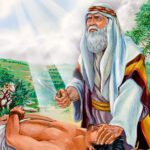Old Testament vs. New Testament: How They Connect and Why They Matter
Introduction
The Bible is mainly divided into two major parts: the Old Testament and the New Testament. Even though Some people see them as two separate books, in reality they are deeply connected, because both sections tells one unified story of God’s redemption plan for humanity. The Old Testament lays the foundation for human redemption, and the New Testament brings about its fulfillment through the death and resurrection of Jesus Christ.
See Also: The Power Of The Cross: The Sacrifice Of Jesus Christ
In this article, we will explore:
– The main differences between the Old Testament and New Testaments
– How the Old Testament connects to the New Testament
– Why both the Old and New Testaments are important for Christians today
Let us go straight into the powerful connection between the two testaments!
1. What Is the Old Testament?
The Old Testament (also called the Hebrew Bible) comprises of 39 books written before the birth of Jesus Christ. It includes:
-The Law (Torah/Pentateuch) – Genesis, Exodus, Leviticus, Numbers, Deuteronomy
-Historical Books – Joshua, Judges, Kings, Chronicles, etc.
-Wisdom Literature – Psalms, Proverbs, Ecclesiastes, Job
-Prophetic Books – Isaiah, Jeremiah, Daniel, Malachi, etc.
Key Themes of the Old Testament
– Creation & the Fall of man – How sin entered the world (Genesis 1-3)
– God’s Covenant with Israel – His promises to Abraham, Moses, and David
– The Law – God’s commandments given to Israel
– Prophecies of the Messiah – Foretelling the coming of Jesus Christ
Reflection: The Old Testament shows entire humanity’s need for a Savior.
Recommended: What Does It Mean To Be Saved: A Biblical Guide
2. What Is the New Testament?
The New Testament comprises of 27 books, written after the resurrection of Jesus Christ, and reveals the fulfillment of God’s promise for man’s redemption. It includes:
-The Gospels – Matthew, Mark, Luke, and John (Life of Jesus)
-Acts of the Apostles – The early church’s growth
-The Epistles (Letters) – Teachings for believers (Romans, Corinthians, Ephesians, etc.)
-Revelation – The prophecy of Christ’s return
Key Themes of the New Testament
– Jesus Christ as the Fulfillment – He is the promised Messiah
– Salvation through Grace – Not by works, but through faith in Jesus Christ (Ephesians 2:8-9)
– The Birth of the Church – Spreading the Gospel of Jesus Christ to all nations
– The Hope of Eternal Life – Jesus’ second coming and God’s kingdom
– Reflection: The New Testament reveals God’s plan of salvation through Jesus Christ.
Can A Christian Be Demon Possessed: A Biblical Perspective
3. The connection between the Old and New Testaments
1. Jesus Fulfills Old Testament Prophecies
The Old Testament consists of over 300 prophecies about the coming of Jesus Christ into the human world. Jesus Christ fulfilled them, proving He is the Messiah.
– Isaiah 7:14 – “The virgin will conceive and give birth to a son.”
– Fulfilled in Matthew 1:23 – Jesus was born of the Virgin Mary.
– Micah 5:2 – “But you, Bethlehem, though you are small… out of you will come a ruler.”
– Fulfilled in Luke 2:4-7 – Jesus was born in Bethlehem.
2. The Law and Grace
The Old Testament law (Mosaic Law) was given to guide God’s people (Israel), but it could not save them. The New Testament demonstrates that Jesus Christ is the fulfillment of the law and offers salvation through grace.
– Matthew 5:17 – “Do not think that I have come to abolish the Law or the Prophets; I have not come to abolish them but to fulfill them.”
– Romans 10:4 – “Christ is the end of the law so that there may be righteousness for everyone who believes.”
3. Sacrificial System vs. Jesus’ Ultimate Sacrifice
In the Old Testament, animal sacrifices were needed for the forgiveness of sins. The New Testament reveals that Jesus Christ became the final sacrifice for sin.
– Hebrews 10:10 – “We have been made holy through the sacrifice of the body of Jesus Christ once for all.”
4. The Old Covenant and the New Covenant
The Old Testament is based on the Old Covenant (God’s law given to Israel). The New Testament introduces the New Covenant through Jesus Christ.
– Jeremiah 31:31 – “The days are coming, declares the Lord, when I will make a new covenant.”
– Fulfilled in Luke 22:20 – “This cup is the new covenant in my blood, which is poured out for you.”
– Reflection: The New Testament is the fulfillment of the Old Testament’s promises.
Can A Christian Be Cursed: Biblical Truth About Spiritual Protection
4. Why the Old and New Testaments Matter Today
Currently some Christians focus mainly on the New Testament, but in is important to understand that both Testaments are essential to a balanced understanding of the Bible.
1. The Old Testament Shows God’s Faithfulness
• It reveals how God’s promises never fail.
• The stories of Abraham, Moses, and David teach us about faith and obedience.
2. The New Testament Reveals God’s Grace through Jesus Christ
• Jesus’ life, death, and resurrection provide salvation.
• The epistles teach us how to live as followers of Christ.
3. Together, They Reveal God’s Full Plan for man’s redemption
• The Old Testament lays the foundation; the New Testament completes the story.
• Both show God’s love, justice, mercy, and grace.
– 2 Timothy 3:16 – “All Scripture is God-breathed and is useful for teaching, rebuking, correcting, and training in righteousness.”
– Reflection: We need both the Old and New Testaments to fully understand God’s plan for salvation.
Conclusion: One Unified Story of Redemption
The Bible is not two separate books, it is one big story of God’s love and redemption plan for humanity. The Old Testament points to Jesus Christ , and the New Testament reveals Him as the Savior and Lord of all.
The Role Of Israel In Bible Prophecy: Romans 11 And Old Testament Promises
Key Takeaways:
– The Old Testament prophesied about the coming of Jesus Christ into the human world.
– The New Testament fulfills those prophecies.
– Together, they reveal God’s complete plan of salvation for the entire universe.
-Hebrews 13:8 – “Jesus Christ is the same yesterday, today, and forever.”
25 Easter Quotes For The Celebration Of Christ Resurrection
Last modified: March 1, 2025


